AMD Ryzen 9 5980HS Cezanne Review: Ryzen 5000 Mobile Tested
by Dr. Ian Cutress on January 26, 2021 9:00 AM EST- Posted in
- CPUs
- AMD
- Vega
- Ryzen
- Zen 3
- Renoir
- Notebook
- Ryzen 9 5980HS
- Ryzen 5000 Mobile
- Cezanne
CPU Tests: Simulation
Simulation and Science have a lot of overlap in the benchmarking world, however for this distinction we’re separating into two segments mostly based on the utility of the resulting data. The benchmarks that fall under Science have a distinct use for the data they output – in our Simulation section, these act more like synthetics but at some level are still trying to simulate a given environment.
DigiCortex v1.35: link
DigiCortex is a pet project for the visualization of neuron and synapse activity in the brain. The software comes with a variety of benchmark modes, and we take the small benchmark which runs a 32k neuron/1.8B synapse simulation, similar to a small slug.
The results on the output are given as a fraction of whether the system can simulate in real-time, so anything above a value of one is suitable for real-time work. The benchmark offers a 'no firing synapse' mode, which in essence detects DRAM and bus speed, however we take the firing mode which adds CPU work with every firing.
The software originally shipped with a benchmark that recorded the first few cycles and output a result. So while fast multi-threaded processors this made the benchmark last less than a few seconds, slow dual-core processors could be running for almost an hour. There is also the issue of DigiCortex starting with a base neuron/synapse map in ‘off mode’, giving a high result in the first few cycles as none of the nodes are currently active. We found that the performance settles down into a steady state after a while (when the model is actively in use), so we asked the author to allow for a ‘warm-up’ phase and for the benchmark to be the average over a second sample time.
For our test, we give the benchmark 20000 cycles to warm up and then take the data over the next 10000 cycles seconds for the test – on a modern processor this takes 30 seconds and 150 seconds respectively. This is then repeated a minimum of 10 times, with the first three results rejected. Results are shown as a multiple of real-time calculation.
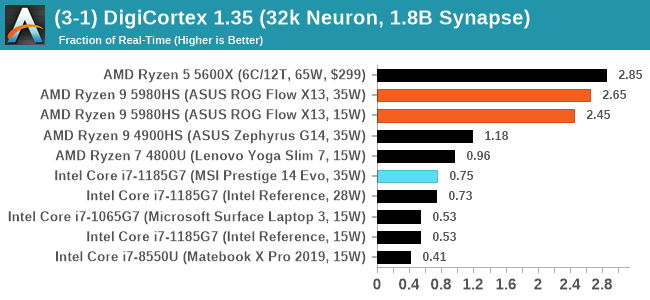
DigiCortex seems to have taken a shine to Zen 3, especially processors with a single chiplet of cores. Intel can't seem to compete here.
Dwarf Fortress 0.44.12: Link
Another long standing request for our benchmark suite has been Dwarf Fortress, a popular management/roguelike indie video game, first launched in 2006 and still being regularly updated today, aiming for a Steam launch sometime in the future.
Emulating the ASCII interfaces of old, this title is a rather complex beast, which can generate environments subject to millennia of rule, famous faces, peasants, and key historical figures and events. The further you get into the game, depending on the size of the world, the slower it becomes as it has to simulate more famous people, more world events, and the natural way that humanoid creatures take over an environment. Like some kind of virus.
For our test we’re using DFMark. DFMark is a benchmark built by vorsgren on the Bay12Forums that gives two different modes built on DFHack: world generation and embark. These tests can be configured, but range anywhere from 3 minutes to several hours. After analyzing the test, we ended up going for three different world generation sizes:
- Small, a 65x65 world with 250 years, 10 civilizations and 4 megabeasts
- Medium, a 127x127 world with 550 years, 10 civilizations and 4 megabeasts
- Large, a 257x257 world with 550 years, 40 civilizations and 10 megabeasts
DFMark outputs the time to run any given test, so this is what we use for the output. We loop the small test for as many times possible in 10 minutes, the medium test for as many times in 30 minutes, and the large test for as many times in an hour.
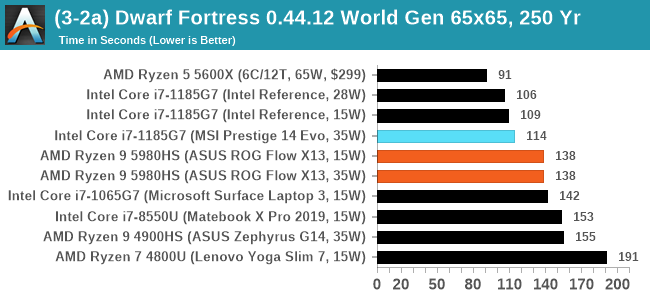
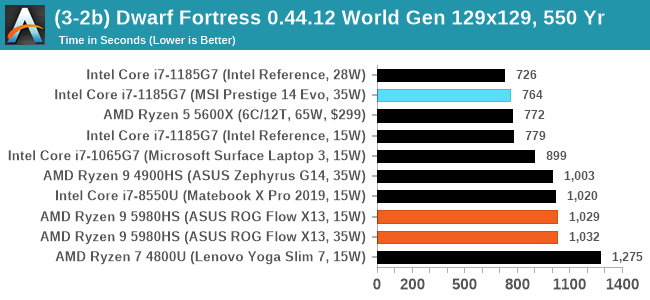
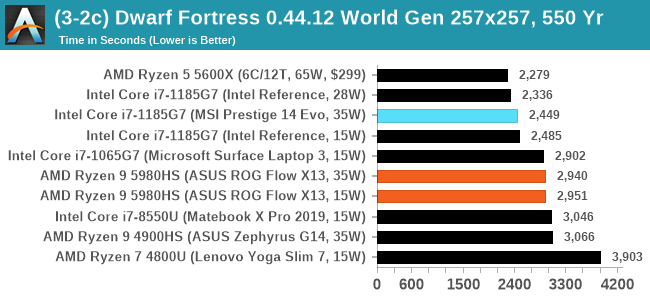
DF has historically been an Intel favorite, and we're not seeing much of a speedup for mobile Zen 3 over mobile Zen 2 here.
Dolphin v5.0 Emulation: Link
Many emulators are often bound by single thread CPU performance, and general reports tended to suggest that Haswell provided a significant boost to emulator performance. This benchmark runs a Wii program that ray traces a complex 3D scene inside the Dolphin Wii emulator. Performance on this benchmark is a good proxy of the speed of Dolphin CPU emulation, which is an intensive single core task using most aspects of a CPU. Results are given in seconds, where the Wii itself scores 1051 seconds.
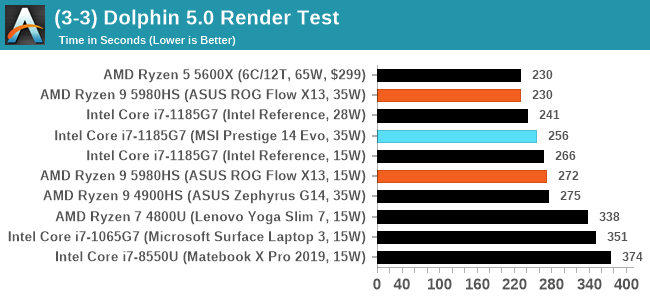
The 35W variant of Cezanne pushes through here, matching the desktop processor, and a sizeable performance jump over the previous generation Renoir.












218 Comments
View All Comments
ToTTenTranz - Tuesday, January 26, 2021 - link
Is there any mention to the number and speed of PCIe lanes on Cezanne?I've been seeing reports of it only having x8 PCIe 3.0 lanes, which could present a problem to AMD's apparent goal of pairing Cezanne with discrete GPUs.
Also, I've read the explanation for the super weird resolutions chosen for the IGP tests, but it still comes off as rather irrelevant.
The author first claims the IGP is good for eSports, but then there are no eSports games being tested.
eSports is also apparently the reason the author is trying to pull >60FPS out of these SoCs, but I don't see a single title that anyone would want to play at those framerates.
The memory bandwidth limitation is also presented as a fact to be aware of, but then the author chooses very low render resolutions that are less likely to be impacted by memory bandwidth.
The Vega 8 at 2100MHz has a fillrate between the Xbox One and the PS4, a compute performance well above the PS4 and with LPDDR4X it has a memory bandwidth similar to that of the XBox One (without eDRAM).
IMO it would be a much more interesting procedure to test 8th-gen multiplatform games at resolutions and settings similar to the 8th-gen consoles, than trying to push Borderlands 3 to run at 90FPS at a 360p resolution that no one is ever going to enable.
The only useful result I see in there is FFXV at 720p medium.
Makaveli - Tuesday, January 26, 2021 - link
Why is apple silicon the "true challenge"I've already invested into the X86 eco system and all my software is there, why would I even consider an M1 regardless or performance?
And the same could be said for someone invested in the apple eco why would they even look at an x86 product?
pSupaNova - Tuesday, January 26, 2021 - link
Because a laptop that can run for hours/days with light use, is performant, does not need a fan is going to fly of the shelves.Watch Apple's market share explode as x86 users switch.
Ptosio - Tuesday, January 26, 2021 - link
I'm quite sure there'd be plenty Zen 3 designs that can run fanless for 10h+ with performance enough for 90% of users on the web/streaming/office etc. And that's before gets access to TSMC 5nm.For typical user invested in Windows/x86 software, there's still no compelling reason to switch to Apple silicon. Plus, at the price MacBooks go, you can get features unheard of in the Apple world, such as 4k OLED, touchscreen with stylus, 360 design, upgradable memory (affordable 32GB RAM and 4TB storage for less than Apple would charge for 8/1), discrete GPU with vast games' catalogue...
Not to take away from M1 superiority, but x86 is still simply good enough and would only get better.
Meteor2 - Thursday, February 4, 2021 - link
A typical user invested in x86 isn't going to change to Apple, no, but they're not the typical user. THE typical user is a lot more software-agnostic, and yes, ARM Apple is going to take marketshare. It's inevitable.Speedfriend - Wednesday, January 27, 2021 - link
Apple market share explode? That is hilarious. The average cost of a laptop sold last year was $400. Remind me what the cheapest Mac costs? Most purchasers have no idea about relative performance which is why they are still buying laptop with 8th generation Intel inside. Even battery life has little impact when x86 laptop claim to have up to 15 hours.Where Mac will take some share back is in professional designers where they had lost share over the past 5 years. But even then, the lack of multi monitor support may hamper that.
Deicidium369 - Wednesday, January 27, 2021 - link
Apple Market will expand slightly - but not from people moving from PC to Mac. People using a Mac by choice will continue to buy and use AppleThe hoops you need to jump thru for a 2nd monitor is kinda ridiculous - move designed to sell TB docking stations
Deicidium369 - Wednesday, January 27, 2021 - link
I get 12 or 13 hours from my Tiger Lake XPS13 - which is about 10 hours longer than I need...DigitalFreak - Tuesday, January 26, 2021 - link
IIRC, all their current mobile CPUs that support external graphics have 8 PCIe 3.0 lanes. That's more than enough for any dedicated GPU in a laptop right now.ToTTenTranz - Tuesday, January 26, 2021 - link
All current external GPUs have an immense bottleneck due to Thunderbolt 3.0 only using 4 PCIe 3.0 lanes.I don't know if Asus' 8x solution is enough, either.